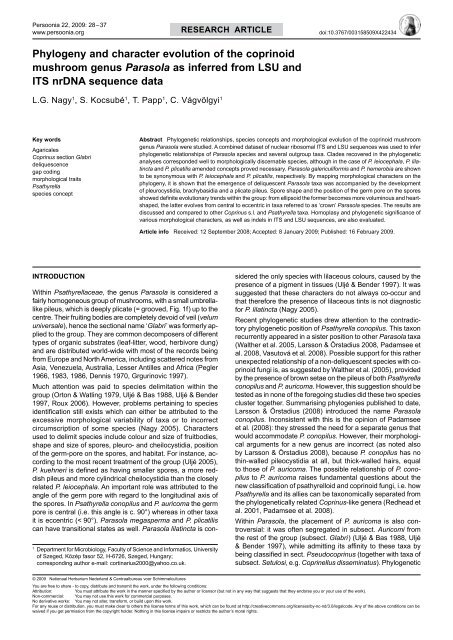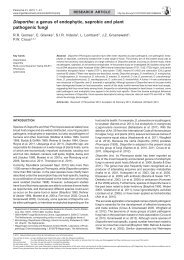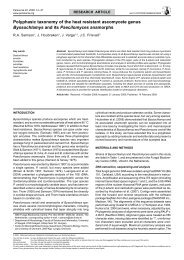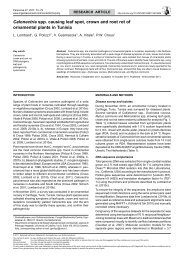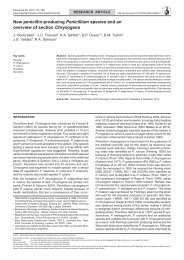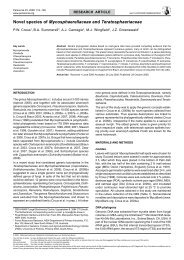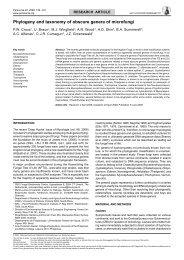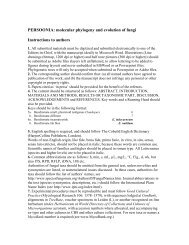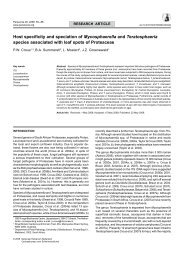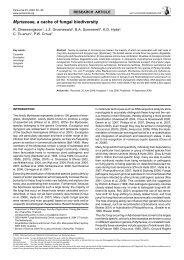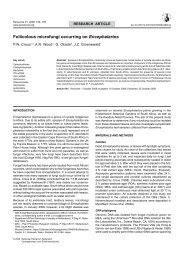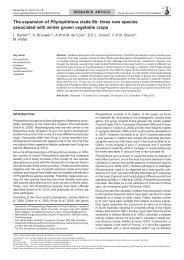Phylogeny and character evolution of the coprinoid ... - Persoonia
Phylogeny and character evolution of the coprinoid ... - Persoonia
Phylogeny and character evolution of the coprinoid ... - Persoonia
You also want an ePaper? Increase the reach of your titles
YUMPU automatically turns print PDFs into web optimized ePapers that Google loves.
<strong>Persoonia</strong> 22, 2009: 28–37<br />
www.persoonia.org<br />
RESEARCH ARTICLE<br />
doi:10.3767/003158509X422434<br />
<strong>Phylogeny</strong> <strong>and</strong> <strong>character</strong> <strong>evolution</strong> <strong>of</strong> <strong>the</strong> <strong>coprinoid</strong><br />
mushroom genus Parasola as inferred from LSU <strong>and</strong><br />
ITS nrDNA sequence data<br />
L.G. Nagy 1 , S. Kocsubé 1 , T. Papp 1 , C. Vágvölgyi 1<br />
Key words<br />
Agaricales<br />
Coprinus section Glabri<br />
deliquescence<br />
gap coding<br />
morphological traits<br />
Psathyrella<br />
species concept<br />
Abstract Phylogenetic relationships, species concepts <strong>and</strong> morphological <strong>evolution</strong> <strong>of</strong> <strong>the</strong> <strong>coprinoid</strong> mushroom<br />
genus Parasola were studied. A combined dataset <strong>of</strong> nuclear ribosomal ITS <strong>and</strong> LSU sequences was used to infer<br />
phylogenetic relationships <strong>of</strong> Parasola species <strong>and</strong> several outgroup taxa. Clades recovered in <strong>the</strong> phylogenetic<br />
analyses corresponded well to morphologically discernable species, although in <strong>the</strong> case <strong>of</strong> P. leiocephala, P. lilatincta<br />
<strong>and</strong> P. plicatilis amended concepts proved necessary. Parasola galericuliformis <strong>and</strong> P. hemerobia are shown<br />
to be synonymous with P. leiocephala <strong>and</strong> P. plicatilis, respectively. By mapping morphological <strong>character</strong>s on <strong>the</strong><br />
phylogeny, it is shown that <strong>the</strong> emergence <strong>of</strong> deliquescent Parasola taxa was accompanied by <strong>the</strong> development<br />
<strong>of</strong> pleurocystidia, brachybasidia <strong>and</strong> a plicate pileus. Spore shape <strong>and</strong> <strong>the</strong> position <strong>of</strong> <strong>the</strong> germ pore on <strong>the</strong> spores<br />
showed definite <strong>evolution</strong>ary trends within <strong>the</strong> group: from ellipsoid <strong>the</strong> former becomes more voluminous <strong>and</strong> heartshaped,<br />
<strong>the</strong> latter evolves from central to eccentric in taxa referred to as ‘crown’ Parasola species. The results are<br />
discussed <strong>and</strong> compared to o<strong>the</strong>r Coprinus s.l. <strong>and</strong> Psathyrella taxa. Homoplasy <strong>and</strong> phylogenetic significance <strong>of</strong><br />
various morphological <strong>character</strong>s, as well as indels in ITS <strong>and</strong> LSU sequences, are also evaluated.<br />
Article info Received: 12 September 2008; Accepted: 8 January 2009; Published: 16 February 2009.<br />
Introduction<br />
1<br />
Department for Microbiology, Faculty <strong>of</strong> Science <strong>and</strong> Informatics, University<br />
<strong>of</strong> Szeged, Közép fasor 52, H-6726, Szeged, Hungary;<br />
corresponding author e-mail: cortinarius2000@yahoo.co.uk.<br />
Within Psathyrellaceae, <strong>the</strong> genus Parasola is considered a<br />
fairly homogeneous group <strong>of</strong> mushrooms, with a small umbrellalike<br />
pileus, which is deeply plicate (= grooved, Fig. 1f) up to <strong>the</strong><br />
centre. Their fruiting bodies are completely devoid <strong>of</strong> veil (velum<br />
universale), hence <strong>the</strong> sectional name ‘Glabri’ was formerly applied<br />
to <strong>the</strong> group. They are common decomposers <strong>of</strong> different<br />
types <strong>of</strong> organic substrates (leaf-litter, wood, herbivore dung)<br />
<strong>and</strong> are distributed world-wide with most <strong>of</strong> <strong>the</strong> records being<br />
from Europe <strong>and</strong> North America, including scattered notes from<br />
Asia, Venezuela, Australia, Lesser Antilles <strong>and</strong> Africa (Pegler<br />
1966, 1983, 1986, Dennis 1970, Grgurinovic 1997).<br />
Much attention was paid to species delimitation within <strong>the</strong><br />
group (Orton & Watling 1979, Uljé & Bas 1988, Uljé & Bender<br />
1997, Roux 2006). However, problems pertaining to species<br />
identification still exists which can ei<strong>the</strong>r be attributed to <strong>the</strong><br />
excessive morphological variability <strong>of</strong> taxa or to incorrect<br />
circumscription <strong>of</strong> some species (Nagy 2005). Characters<br />
used to delimit species include colour <strong>and</strong> size <strong>of</strong> fruitbodies,<br />
shape <strong>and</strong> size <strong>of</strong> spores, pleuro- <strong>and</strong> cheilocystidia, position<br />
<strong>of</strong> <strong>the</strong> germ-pore on <strong>the</strong> spores, <strong>and</strong> habitat. For instance, according<br />
to <strong>the</strong> most recent treatment <strong>of</strong> <strong>the</strong> group (Uljé 2005),<br />
P. kuehneri is defined as having smaller spores, a more reddish<br />
pileus <strong>and</strong> more cylindrical cheilocystidia than <strong>the</strong> closely<br />
related P. leiocephala. An important role was attributed to <strong>the</strong><br />
angle <strong>of</strong> <strong>the</strong> germ pore with regard to <strong>the</strong> longitudinal axis <strong>of</strong><br />
<strong>the</strong> spores. In Psathyrella conopilus <strong>and</strong> P. auricoma <strong>the</strong> germ<br />
pore is central (i.e. this angle is c. 90°) whereas in o<strong>the</strong>r taxa<br />
it is eccentric (< 90°). Parasola megasperma <strong>and</strong> P. plicatilis<br />
can have transitional states as well. Parasola lilatincta is considered<br />
<strong>the</strong> only species with lilaceous colours, caused by <strong>the</strong><br />
presence <strong>of</strong> a pigment in tissues (Uljé & Bender 1997). It was<br />
suggested that <strong>the</strong>se <strong>character</strong>s do not always co-occur <strong>and</strong><br />
that <strong>the</strong>refore <strong>the</strong> presence <strong>of</strong> lilaceous tints is not diagnostic<br />
for P. lilatincta (Nagy 2005).<br />
Recent phylogenetic studies drew attention to <strong>the</strong> contradictory<br />
phylogenetic position <strong>of</strong> Psathyrella conopilus. This taxon<br />
recurrently appeared in a sister position to o<strong>the</strong>r Parasola taxa<br />
(Wal<strong>the</strong>r et al. 2005, Larsson & Örstadius 2008, Padamsee et<br />
al. 2008, Vasutová et al. 2008). Possible support for this ra<strong>the</strong>r<br />
unexpected relationship <strong>of</strong> a non-deliquescent species with <strong>coprinoid</strong><br />
fungi is, as suggested by Wal<strong>the</strong>r et al. (2005), provided<br />
by <strong>the</strong> presence <strong>of</strong> brown setae on <strong>the</strong> pileus <strong>of</strong> both Psathyrella<br />
conopilus <strong>and</strong> P. auricoma. However, this suggestion should be<br />
tested as in none <strong>of</strong> <strong>the</strong> foregoing studies did <strong>the</strong>se two species<br />
cluster toge<strong>the</strong>r. Summarising phylogenies published to date,<br />
Larsson & Örstadius (2008) introduced <strong>the</strong> name Parasola<br />
conopilus. Inconsistent with this is <strong>the</strong> opinion <strong>of</strong> Padamsee<br />
et al. (2008): <strong>the</strong>y stressed <strong>the</strong> need for a separate genus that<br />
would accommodate P. conopilus. However, <strong>the</strong>ir morphological<br />
arguments for a new genus are incorrect (as noted also<br />
by Larsson & Örstadius 2008), because P. conopilus has no<br />
thin-walled pileocystidia at all, but thick-walled hairs, equal<br />
to those <strong>of</strong> P. auricoma. The possible relationship <strong>of</strong> P. conopilus<br />
to P. auricoma raises fundamental questions about <strong>the</strong><br />
new classification <strong>of</strong> psathyrelloid <strong>and</strong> <strong>coprinoid</strong> fungi, i.e. how<br />
Psathyrella <strong>and</strong> its allies can be taxonomically separated from<br />
<strong>the</strong> phylogenetically related Coprinus-like genera (Redhead et<br />
al. 2001, Padamsee et al. 2008).<br />
Within Parasola, <strong>the</strong> placement <strong>of</strong> P. auricoma is also controversial:<br />
it was <strong>of</strong>ten segregated in subsect. Auricomi from<br />
<strong>the</strong> rest <strong>of</strong> <strong>the</strong> group (subsect. Glabri) (Uljé & Bas 1988, Uljé<br />
& Bender 1997), while admitting its affinity to <strong>the</strong>se taxa by<br />
being classified in sect. Pseudocoprinus (toge<strong>the</strong>r with taxa <strong>of</strong><br />
subsect. Setulosi, e.g. Coprinellus disseminatus). Phylogenetic<br />
© 2009 Nationaal Herbarium Nederl<strong>and</strong> & Centraalbureau voor Schimmelcultures<br />
You are free to share - to copy, distribute <strong>and</strong> transmit <strong>the</strong> work, under <strong>the</strong> following conditions:<br />
Attribution:<br />
You must attribute <strong>the</strong> work in <strong>the</strong> manner specified by <strong>the</strong> author or licensor (but not in any way that suggests that <strong>the</strong>y endorse you or your use <strong>of</strong> <strong>the</strong> work).<br />
Non-commercial: You may not use this work for commercial purposes.<br />
No derivative works: You may not alter, transform, or build upon this work.<br />
For any reuse or distribution, you must make clear to o<strong>the</strong>rs <strong>the</strong> license terms <strong>of</strong> this work, which can be found at http://creativecommons.org/licenses/by-nc-nd/3.0/legalcode. Any <strong>of</strong> <strong>the</strong> above conditions can be<br />
waived if you get permission from <strong>the</strong> copyright holder. Nothing in this license impairs or restricts <strong>the</strong> author’s moral rights.
L.G. Nagy et al.: <strong>Phylogeny</strong> <strong>and</strong> <strong>character</strong> <strong>evolution</strong> <strong>of</strong> Parasola spp.<br />
29<br />
a<br />
b<br />
c<br />
d<br />
e<br />
g<br />
Fig. 1 Examples <strong>of</strong> different species <strong>of</strong> Parasola. a. P. conopilus; b, c. P. auricoma, young <strong>and</strong> mature fruitbodies; d. fruitbody <strong>of</strong> P. misera, <strong>the</strong> only obligate<br />
coprophilous taxon. e. P. leiocephala; f. mature fruitbody <strong>of</strong> P. lilatincta showing typical plicate pileus surface; g. young fruitbody <strong>of</strong> P. lilatincta with conspicuous<br />
lilaceous coloration. — Photos by: a–f. L.G. Nagy; g. Derek Schafer.<br />
f<br />
studies published so far agree that P. auricoma is a member<br />
<strong>of</strong> <strong>the</strong> Parasola clade (Hopple & Vilgalys 1999, Moncalvo et<br />
al. 2002, Wal<strong>the</strong>r et al. 2005, Padamsee et al. 2008), but its<br />
position within that group is still obscure due to limited sampling<br />
<strong>of</strong> Parasola taxa.<br />
Studies on fungal trait <strong>evolution</strong> mainly concentrated on features<br />
that are conserved at <strong>the</strong> family-phylum level (Lutzoni et al.<br />
2001, Hibbett & Donoghue 2001, Hibbett 2004, Aanen & Eggleton<br />
2005). Hence, very little is known about <strong>the</strong> phylogenetic<br />
value <strong>of</strong> morphological <strong>character</strong>s at or below genus level. However,<br />
before extrapolating phylogenetic results to classification,<br />
we think it is essential to know how morphological traits evolve.<br />
Upholding classification, comparative phylogenetic methods<br />
may facilitate selection <strong>of</strong> morphological features that are less<br />
homoplasious or show definite trends. Within dark-spored agarics,<br />
Frøslev et al. (2007) reported extensive conservation <strong>of</strong><br />
distribution <strong>of</strong> certain chemical <strong>character</strong>s at species or group<br />
level in callochroid taxa <strong>of</strong> <strong>the</strong> genus Cortinarius. Padamsee<br />
et al. (2008) mapped a series <strong>of</strong> morphological features on
30 <strong>Persoonia</strong> – Volume 22, 2009<br />
<strong>the</strong> phylogeny (e.g., cystidial wall, presence <strong>of</strong> brachybasidia<br />
or pleurocystidia) <strong>of</strong> <strong>coprinoid</strong> fungi, but found most <strong>of</strong> <strong>the</strong>m<br />
strongly homoplasious, which suggests <strong>character</strong>s in this group<br />
should be mapped on a smaller scale to get more reliable estimates<br />
<strong>of</strong> <strong>the</strong> nature <strong>of</strong> <strong>the</strong>se traits.<br />
In this study we address generic limits <strong>of</strong> Parasola based on a<br />
broad sampling <strong>of</strong> nrLSU <strong>and</strong> ITS sequences. Data from <strong>the</strong><br />
two genes (nrLSU <strong>and</strong> ITS) <strong>and</strong> indel <strong>character</strong>s <strong>of</strong> 38 Parasola<br />
specimens, representing all but one morphologically distinct<br />
species, are combined in order to investigate species limits <strong>and</strong><br />
intrageneric relationships. Specimens identified as P. galericuliformis<br />
<strong>and</strong> P. hemerobia were also included. Special attention<br />
is paid to <strong>the</strong> limits <strong>of</strong> P. lilatincta as compared to P. leiocephala<br />
<strong>and</strong> P. schroeteri, in order to ascertain <strong>the</strong> diagnostic<br />
utility <strong>of</strong> lilaceous coloration <strong>and</strong> spore size. Homoplasy <strong>and</strong> <strong>the</strong><br />
extent <strong>of</strong> conservation exhibited by <strong>the</strong> morphological <strong>character</strong>s<br />
used to delineate species are estimated by mapping <strong>the</strong>m<br />
onto <strong>the</strong> phylogeny <strong>of</strong> Parasola taxa. A resulting hypo<strong>the</strong>sis <strong>of</strong><br />
<strong>evolution</strong> <strong>of</strong> morphological traits in Parasola is presented <strong>and</strong><br />
discussed.<br />
Materials <strong>and</strong> methods<br />
Taxon sampling<br />
Specimens for this study were ei<strong>the</strong>r field-collected or loaned<br />
from public herbaria. Identifications were based on type studies<br />
<strong>and</strong> two revisions (Uljé & Bas 1988, Uljé & Bender 1997) supplemented<br />
with experiences <strong>of</strong> a revision <strong>of</strong> > 500 herbarium<br />
specimens <strong>of</strong> all Parasola taxa by L.N. Freshly collected fruitbodies<br />
were dried in Silica gel to prevent tissues from collapsing.<br />
Collections within one species were chosen preferably from<br />
diverse geographical regions to reflect potential intraspecific<br />
differences.<br />
Table 1 Origin, herbarium number, <strong>and</strong> GenBank accession numbers <strong>of</strong> specimens used in this study.<br />
Species Locality Voucher No. Identifier GenBank No.<br />
Coprinellus impatiens Hungary, Alföld SZMC-NL-1164 L. Nagy FM160732 FM163177<br />
Coprinellus heptemerus Hungary, Alföld SZMC-NL-2144 L. Nagy FM160731 FM163178<br />
Coprinopsis lagopus Hungary, Alföld SZMC-NL-2143 L. Nagy FM160730 FM163179<br />
Coprinopsis narcotica Hungary, Alföld SZMC-NL-2342 L. Nagy FM160729 FM163180<br />
Coprinopsis pseudoniveus Hungary, Alföld SZMC-NL-2340 L. Nagy FM160728 FM163181<br />
‘Coprinus’ poliomallus Hungary, Alföld SZMC-NL-2336 L. Nagy FM160727 FM163182<br />
‘Coprinus’ bellulus Hungary, Alföld SZMC-NL-2341 L. Nagy FM160680 FM163176<br />
Lacrymaria lacrymabunda Sweden, Stockholm SZMC-NL-0082 L. Nagy FM160726 FM163183<br />
Sweden, Öl<strong>and</strong> SZMC-NL-2140 L. Nagy FM160725 FM163184<br />
Parasola auricoma Hungary, Alföld SZMC-NL-0087 L. Nagy FM160724 FM163185<br />
Hungary, Alföld SZMC-NL-0268 L. Nagy FM160723 FM163187<br />
Parasola conopilus Hungary, Alföld SZMC-NL-0465 L. Nagy FM160686 FM163223<br />
Hungary, Alföld SZMC-NL-0286 L. Nagy FM160685 FM163224<br />
Hungary, Alföld SZMC-NL-0285 L. Nagy FM160684 FM163225<br />
Parasola galericuliformis Hungary, Alföld SZMC-NL-6601 L. Nagy FM160722 FM163187<br />
Sweden, Öl<strong>and</strong> SZMC-NL-0095 L. Nagy FM160721 FM163188<br />
Parasola hemerobia Hungary, Északi Középhegység SZMC-NL-0284 L. Nagy FM160720 FM163189<br />
Parasola hercules Ne<strong>the</strong>rl<strong>and</strong>s, Rijswijk Uljé 1269 (L) C.B. Uljé FM160719 FM163190<br />
Parasola kuehneri Ne<strong>the</strong>rl<strong>and</strong>s, Alphen aan den Rijn Uljé 904 (L) C.B. Uljé FM160718 FM163191<br />
Parasola leiocephala Hungary, Alföld SZMC-NL-0466 L. Nagy FM160717 FM163192<br />
Sweden, Öl<strong>and</strong> SZMC-NL-0288 L. Nagy FM160716 FM163193<br />
Germany, Tübingen SZMC-NL-0283 L. Nagy FM160715 FM163194<br />
Parasola lilatincta Hungary, Alföld SZMC-NL-0660 L. Nagy FM160714 FM163195<br />
Hungary, Alföld SZMC-NL-0296 L. Nagy FM160713 FM163196<br />
Hungary, Alföld SZMC-NL-0281 L. Nagy FM160712 FM163197<br />
Hungary, Alföld SZMC-NL-0667 L. Nagy FM160711 FM163199<br />
Hungary, Alföld SZMC-NL-0472 L. Nagy FM160710 FM163199<br />
Hungary, Alföld SZMC-NL-0468a L. Nagy FM160709 FM163200<br />
Engl<strong>and</strong>, Perthshire D. Schafer 2382004 L. Nagy FM160708 FM163201<br />
Ne<strong>the</strong>rl<strong>and</strong>s, Leiden Arnolds 6939 (L) C.B. Uljé FM160707 FM163202<br />
Hungary, Alföld SZMC-NL-0683 L. Nagy FM160706 FM163203<br />
Parasola aff. lilatincta Hungary, Északi Középhegység SZMC-NL-0086 L. Nagy FM160705 FM163204<br />
Sweden, Öl<strong>and</strong> SZMC-NL-0096 L. Nagy FM160704 FM163205<br />
Parasola megasperma Denmark, Jutl<strong>and</strong> C 19683 (C) L. Nagy FM160703 FM163206<br />
Spain, Gurmá Zuzones AH 13089 L. Nagy FM160702 FM163207<br />
Sweden, Öl<strong>and</strong> SZMC-NL-1924 L. Nagy FM160701 FM163208<br />
Parasola misera Hungary, Alföld SZMC-NL-0490 L. Nagy FM160700 FM163209<br />
Hungary, Északi Középhegység SZMC-NL-0280 L. Nagy FM160699 FM163210<br />
Hungary, Alföld SZMC-NL-0677 L. Nagy FM160698 FM163211<br />
Parasola plicatilis Sweden, Öl<strong>and</strong> SZMC-NL-0477 L. Nagy FM160697 FM163212<br />
Hungary, Alföld SZMC-NL-0075a L. Nagy FM160696 FM163213<br />
Hungary, Alföld SZMC-NL-0075 L. Nagy FM160695 FM163214<br />
Sweden, Öl<strong>and</strong> SZMC-NL-0097 L. Nagy FM160694 FM163215<br />
Hungary, Alföld SZMC-NL-0295 L. Nagy FM160693 FM163216<br />
Parasola schroeteri Denmark, Arslev Klamer 061998 (C) L. Nagy FM160692 FM163217<br />
Sweden, Öl<strong>and</strong> SZMC-NL-0287 L. Nagy FM160691 FM163218<br />
Ne<strong>the</strong>rl<strong>and</strong>s, Hilversum Briër 1051999 (L) C.B. Uljé FM160690 FM163219<br />
Psathyrella ammophila Hungary, Alföld SZMC-NL-2151 L. Nagy FM160689 FM163220<br />
Psathyrella bipellis Hungary, Alföld SZMC-NL-2535 L. Nagy FM160688 FM163221<br />
Psathyrella prona var. utriformis Hungary, Alföld SZMC-NL-2534 L. Nagy FM160687 FM163222<br />
Psathyrella leucotephra Hungary, Alföld SZMC-NL-1953 L. Nagy FM160683 FM163226<br />
Psathyrella magnispora Hungary, Alföld SZMC-NL-1954 L. Nagy FM160682 FM163227<br />
Psathyrella phaseolispora Hungary, Alföld SZMC-NL-1952 L. Nagy FM160681 FM163228<br />
1<br />
Herbarium <strong>of</strong> Szeged Microbiological Collection.<br />
LSU<br />
ITS
L.G. Nagy et al.: <strong>Phylogeny</strong> <strong>and</strong> <strong>character</strong> <strong>evolution</strong> <strong>of</strong> Parasola spp.<br />
31<br />
In order to infer species limits, it was intended to sample at<br />
least three independent specimens from each morphological<br />
species <strong>of</strong> Parasola recognised by us during morphological<br />
studies (Nagy et al. unpubl.); thus we sampled 38 collections<br />
<strong>of</strong> <strong>the</strong> following 11 taxa: Parasola auricoma, P. galericuliformis,<br />
P. hemerobia, P. hercules, P. kuehneri, P. leiocephala, P. lilatincta,<br />
P. megasperma, P. misera, P. plicatilis <strong>and</strong> P. schroeteri<br />
(Table 1). O<strong>the</strong>r taxa combined in Parasola were ignored in this<br />
study ei<strong>the</strong>r because <strong>the</strong>y are widely accepted synonyms <strong>of</strong><br />
o<strong>the</strong>r taxa we included (P. nudiceps) or are considered dubious<br />
or insufficiently known (Uljé & Bas 1988, Nagy et al. unpubl.).<br />
The only well-<strong>character</strong>ised species for which we did not generate<br />
sequence data is P. setulosa, as this taxon is known only<br />
from <strong>the</strong> type specimen from <strong>the</strong> 1870s. GenBank sequences<br />
were not included in <strong>the</strong> LSU dataset because species limits<br />
are not settled in this group, so misidentifications are likely; <strong>the</strong><br />
more so because little is known about <strong>the</strong> specimens from which<br />
<strong>the</strong> sequences were generated. Three additional specimens <strong>of</strong><br />
P. conopilus were sampled to assess <strong>the</strong> phylogenetic position<br />
<strong>of</strong> this species with regard to Parasola taxa. Sequences for<br />
fur<strong>the</strong>r 15 taxa, representatives <strong>of</strong> Coprinellus, Coprinopsis <strong>and</strong><br />
Psathyrella were generated in order to infer deep branchings<br />
<strong>of</strong> Psathyrellaceae.<br />
To root all <strong>coprinoid</strong> taxa, we used LSU <strong>and</strong> ITS sequences <strong>of</strong><br />
Mythicomyces corneipes as well as three taxa <strong>of</strong> Agaricaceae<br />
which formerly appeared suitable outgroups for <strong>the</strong> Psathyrellaceae<br />
(Moncalvo et al. 2002, Ma<strong>the</strong>ny et al. 2006, Padamsee<br />
et al. 2008).<br />
Laboratory protocols<br />
DNA extraction was performed according to a modified CTAB<br />
extraction method (Hughes et al. 1999). In cases when this<br />
technique did not work well, we used <strong>the</strong> Qiagen DNeasy<br />
Plant Mini Kit (Qiagen) following <strong>the</strong> manufacturer’s protocol.<br />
In many cases, a brown pigment (putatively that <strong>of</strong> <strong>the</strong> spores)<br />
appeared in <strong>the</strong> final extract which seemed to interfere with <strong>the</strong><br />
PCR reaction. To remove this pigment, <strong>the</strong> DNA Gel Extraction<br />
Kit (Fermentas) was applied; this allowed removal <strong>of</strong> <strong>the</strong> majority<br />
<strong>of</strong> this stain <strong>and</strong> arbitrary enhancement <strong>of</strong> DNA concentration.<br />
Subsequent dilution <strong>of</strong> templates before PCR reactions<br />
was chosen so as to optimise yield <strong>of</strong> <strong>the</strong> desired fragment.<br />
Polymerase Chain Reaction (PCR) was used to amplify ITS <strong>and</strong><br />
LSU regions <strong>of</strong> <strong>the</strong> nuclear ribosomal DNA repeat, employing<br />
<strong>the</strong> following primers: ITS1, ITS1F, ITS4, ITS4B for <strong>the</strong> ITS<br />
region <strong>and</strong> ITS1F, LR7, LR5, 5.8SR <strong>and</strong> LROR for <strong>the</strong> first 1.5<br />
kb <strong>of</strong> <strong>the</strong> LSU gene (Gardes & Bruns 1993, http://www.biology.<br />
duke.edu/fungi/mycolab/primers.htm). PCR reactions were<br />
performed in a total volume <strong>of</strong> 20 μL, following <strong>the</strong> protocol<br />
outlined in White et al. (1990) for both genes. For sequencing<br />
we used <strong>the</strong> same primers as described above for <strong>the</strong> ITS<br />
fragments <strong>and</strong> LR3R, LR16 or LR22 as additional sequencing<br />
primers in case <strong>of</strong> <strong>the</strong> LSU fragments (http://www.biology.<br />
duke.edu/fungi/mycolab/primers.htm). Cycle sequencing was<br />
performed by Macrogen Inc. (Korea). Sequences were assembled<br />
<strong>and</strong> edited in <strong>the</strong> programs Pregap v. 1.5 <strong>and</strong> Gap4 v.4.10<br />
<strong>of</strong> <strong>the</strong> Staden Package (Staden et al. 1998). All sequences<br />
were deposited in GenBank (Table 1), <strong>and</strong> <strong>the</strong> alignment in<br />
TreeBASE (M4246).<br />
Alignments <strong>and</strong> phylogenetic analyses<br />
Assembled sequences were first aligned by ClustalW (Thompson<br />
et al. 1994) <strong>and</strong> inspected by eye. ITS alignments <strong>of</strong>ten<br />
showed high percentage <strong>of</strong> ambiguously aligned sites, which<br />
needed very time-consuming manual correction. To evade this<br />
problem we performed pr<strong>of</strong>ile-to-pr<strong>of</strong>ile alignments in MUS-<br />
CLE (Edgar 2004), which gave improved alignments requiring<br />
much less manual correction. Pr<strong>of</strong>ile-to-pr<strong>of</strong>ile alignments<br />
were carried out on alignments computed with MUSCLE <strong>and</strong><br />
edited manually. Before subjected to phylogenetic analyses,<br />
ambiguously aligned regions were excluded, non-overlapping<br />
start positions <strong>and</strong> ends <strong>of</strong> sequences were trimmed from <strong>the</strong><br />
alignments. Gaps were coded in FastGap v. 1.0.8 (Borchsenius<br />
2007) by means <strong>of</strong> <strong>the</strong> simple indel coding method <strong>of</strong> Simmons<br />
& Ochoterena (2000) in a separate, binary data partition.<br />
Maximum Parsimony (MP), Maximum Likelihood (ML) <strong>and</strong><br />
Bayesian analyses <strong>of</strong> resulting alignments were performed to<br />
infer phylogenetic relationships <strong>of</strong> <strong>the</strong> group. Equally weighted<br />
MP searches were executed in PAUP v. 4.0b10 (Sw<strong>of</strong>ford 2003)<br />
according to <strong>the</strong> following strategy: initial heuristic searches<br />
were performed in 1 000 replicates to identify tree isl<strong>and</strong>s<br />
with saving a maximum <strong>of</strong> 5 trees per replicate (nchuck = 5,<br />
chuckscore = 1, TBR branch-swapping, MAXTREES set to<br />
autoincrease). Subsequent, more thorough branch swapping<br />
was conducted on <strong>the</strong> trees resulting from <strong>the</strong> search outlined<br />
above (start = current, nchuck = 0, chuckscore = 0). Gaps were<br />
treated as missing data. Nodal support was estimated by 1 000<br />
bootstrap replicates with 10 r<strong>and</strong>om sequence additions per<br />
replicate. To assess <strong>the</strong> phylogenetic utility <strong>of</strong> gaps when coded<br />
as separate <strong>character</strong>s, a separate matrix containing only binary<br />
gap data was subjected to <strong>the</strong> same MP analyses as described<br />
above for <strong>the</strong> DNA matrix. Gaps were coded by means <strong>of</strong> <strong>the</strong><br />
simple indel coding regime (Simmons & Ochoterena 2000)<br />
excluding leading <strong>and</strong> trailing gaps, with <strong>the</strong> expectation to<br />
provide more resolving power <strong>and</strong> nodal support (Simmons &<br />
Ochoterena 2000, Simmons et al. 2001, Kawakita et al. 2003).<br />
Rescaled Consistency Index (RCi) <strong>and</strong> Retention index (Ri)<br />
(Farris 1989) were calculated in PAUP for indel data in order to<br />
describe <strong>the</strong> homoplasy exhibited by this <strong>character</strong> type.<br />
Best-fit substitution models used in <strong>the</strong> likelihood-based analyses<br />
were selected by <strong>the</strong> model testing algorithm implemented<br />
in Topali v. 2.19 (Milne et al. 2004). During model selection,<br />
results <strong>of</strong> <strong>the</strong> AIC c<br />
criterion was considered, with sample size<br />
set to alignment size, as suggested by Posada & Buckley<br />
(2004).<br />
ML estimation was performed in PhyML v. 2.4.4 (Guindon &<br />
Gascuel 2003) with 1 000 non-parametric bootstrap replicates.<br />
To discover tree space effectively, <strong>the</strong> program was run several<br />
times by using parsimony trees, recovered in <strong>the</strong> initial MP<br />
searches described above, as user-defined starting trees. Thus<br />
in case <strong>of</strong> <strong>the</strong> ITS+LSU dataset this number was 88 as <strong>the</strong> initial<br />
MP search recovered <strong>the</strong>se trees. In all bootstrap analyses,<br />
values above 70 % were considered significant (Fig. 2).<br />
Bayesian p(MC) 3 analyses were run in MrBayes v. 3.1 (Ronquist<br />
& Huelsenbeck 2003). Metropolis Coupled Markov Chains with<br />
Monte Carlo simulation were run until likelihoods reached stationarity<br />
<strong>and</strong> <strong>the</strong> 2 independent runs converged (as deduced<br />
from <strong>the</strong> average st<strong>and</strong>ard deviation <strong>of</strong> split frequencies, i.e.<br />
< 0.01). Accordingly <strong>the</strong> chains were run three million generations<br />
in case <strong>of</strong> <strong>the</strong> ITS+LSU dataset, while <strong>the</strong> LSU+ITS+binary<br />
matrix required eight million generations (in this case burn-in<br />
was established in 5.5 × 10 6 ). By sampling every 100th generations<br />
from <strong>the</strong> 2 independent runs in MrBayes, <strong>the</strong> analyses<br />
resulted in 45 002 <strong>and</strong> 50 002 trees, respectively (after <strong>the</strong> first<br />
25 % was discarded as burn-in for <strong>the</strong> ITS+LSU dataset <strong>and</strong><br />
<strong>the</strong> first 5.5 × 10 6 generations for <strong>the</strong> LSU+ITS+binary matrix),<br />
which were used to construct 50 % majority rule consensus<br />
phylograms. The phylogeny inferred from <strong>the</strong> ITS+LSU+binary<br />
dataset is presented on Fig. 3. The Binary model implemented<br />
in MrBayes for restriction sites was used for <strong>the</strong> binary (gap)<br />
dataset with <strong>the</strong> comm<strong>and</strong> coding = variable to adjust for <strong>character</strong>s<br />
not included in this matrix, as suggested by Ronquist et<br />
al. (2005). Clades that received posterior probabilities > 0.95<br />
were considered strongly supported.
32 <strong>Persoonia</strong> – Volume 22, 2009<br />
Fig. 2 Maximum Likelihood (-lnL = 9989.930326) tree inferred from combined<br />
LSU+ITS dataset. Numbers above branches represent Maximum<br />
Likelihood, Maximum Parsimony bootstrap values <strong>and</strong> Bayesian Posterior<br />
Probabilities, respectively. Thickened branches receive strong support in at<br />
least one <strong>of</strong> <strong>the</strong> analyses (MP, ML or Bayesian). Two branches indicated by<br />
slanted parallel lines have been truncated for viewing.<br />
Parasola<br />
‘Crown’ Parasola<br />
taxa<br />
Mythicomyces corneipes AY45707<br />
Agaricus bisporus AY635775<br />
Chlorophyllum molybdites AY700187<br />
Coprinus comatus AY635772<br />
Parasola kuehneri Uljé 904<br />
Parasola lilatincta NL-0660<br />
Parasola lilatincta NL-0667<br />
Parasola lilatincta NL-0472<br />
Parasola lilatincta Arnolds 6939<br />
Parasola lilatincta NL-0296<br />
Parasola lilatincta NL-0683<br />
Parasola lilatincta NL-0281<br />
Parasola lilatincta Schafer 2382004<br />
Parasola lilatincta NL-0468<br />
Parasola hercules Uljé 1269<br />
Parasola misera NL-0280 NEOTYPE<br />
Parasola misera NL-0490<br />
Parasola misera NL-0677<br />
Parasola leiocephala NL-0466<br />
Parasola leiocephala NL-0283<br />
Parasola galericuliformis NL-6601<br />
Parasola galericuliformis NL-0095<br />
Parasola leiocephala NL-0288<br />
Parasola aff. lilatincta NL-0086<br />
Parasola aff. lilatincta NL-0096<br />
Parasola megasperma AH 13089<br />
Parasola megasperma NL-1924<br />
Parasola megasperma C 19683<br />
Parasola schroeteri Brier 1051999<br />
Parasola schroeteri Klamer-061998<br />
Parasola schroeteri NL-0287<br />
Parasola plicatilis NL-0477<br />
Parasola plicatilis NL-0097<br />
Parasola hemerobia NL-0284<br />
Parasola plicatilis NL-0075a<br />
Parasola plicatilis NL-0075<br />
Parasola plicatilis NL-0295<br />
Parasola auricoma NL-0268<br />
Parasola auricoma NL-0087 /auricoma<br />
Parasola conopilus NL-0465<br />
Parasola conopilus NL-0286<br />
Parasola conopilus NL-0285<br />
Lacrymaria velutina 2<br />
Lacrymaria velutina 1<br />
Psathyrella ammophila<br />
Psathyrella magnispora<br />
Psathyrella phaseolispora<br />
Coprinellus impatiens<br />
Coprinellus heptemerus<br />
Psathyrella prona var. utriformis<br />
Psathyrella bipellis<br />
Psathyrella leucotephra<br />
Coprinopsis narcotica<br />
‘Coprinus’ poliomallus<br />
Coprinopsis lagopus<br />
Coprinopsis pseudonivea<br />
‘Coprinus’ bellulus<br />
/hercules<br />
/misera<br />
/leiocephala<br />
/aff. lilatincta<br />
/megaspermaschroeteri<br />
/conopilus<br />
/lilatincta<br />
/plicatilis<br />
/kuehneri<br />
Character <strong>evolution</strong><br />
Various morphological <strong>character</strong>s were mapped onto <strong>the</strong> phylogeny<br />
<strong>of</strong> Parasola taxa under <strong>the</strong> parsimony principle. Parsimony<br />
mapping was performed in Mesquite v. 2.01 (Maddison & Maddison<br />
2007) by using both <strong>the</strong> ML tree <strong>and</strong> <strong>the</strong> 50 % majority<br />
rule MP <strong>and</strong> Bayesian trees. The following traits were coded in<br />
a binary matrix <strong>and</strong> traced on <strong>the</strong> trees: veil (present/absent),<br />
fruitbody collapsing (Yes/No), pileus surface (smooth/plicate),<br />
thick-walled hairs on pileus (present/absent), pleurocystidia<br />
(present/absent), brachybasidia (present/absent), germ-pore<br />
(central/eccentric), spore shape (rounded triangular/ellipsoid),<br />
granules in tramal tissues (present/absent). Many studies treat<br />
Parasola as non-deliquescent (Redhead et al. 2001, Padamsee<br />
et al. 2008) while o<strong>the</strong>rs claim that <strong>the</strong>y show deliquescence<br />
to some extent (Orton & Watling 1979, Uljé & Bas 1988, Uljé<br />
2005). By all means, Parasola taxa do differ from closely related<br />
psathyrelloid taxa (including P. conopilus) in that <strong>the</strong>ir fruitbodies<br />
rapidly lose turgor <strong>and</strong> collapse upon maturing. Hence, <strong>the</strong><br />
process exhibited by Parasola taxa is interpreted here as an<br />
intermediate state between deliquescence <strong>and</strong> non-deliquescence<br />
<strong>and</strong> hereafter referred to as ‘collapsing’. Accordingly, we<br />
evaluated <strong>the</strong> phylogenetic utility <strong>of</strong> this <strong>character</strong> as well. The<br />
Rescaled Consistency index (RCi) <strong>and</strong> <strong>the</strong> Retention index<br />
(Ri) were calculated in PAUP v. 4.0b10 (Sw<strong>of</strong>ford 2003) for<br />
each <strong>character</strong>.<br />
RESULTS<br />
Sequence data, alignments <strong>and</strong> utility <strong>of</strong> gaps<br />
as <strong>character</strong>s in phylogenetic analyses<br />
The ITS1-5.8S-ITS2 regions <strong>and</strong> approximately <strong>the</strong> first 1 500<br />
bp <strong>of</strong> <strong>the</strong> LSU gene were successfully sequenced for 38 specimens<br />
<strong>of</strong> <strong>the</strong> ingroup taxa. Old or extremely minute specimens<br />
<strong>of</strong>ten proved difficult to use for DNA extraction, accordingly,<br />
P. hercules <strong>and</strong> P. kuehneri are represented by one sequence<br />
each in <strong>the</strong> alignment. Additional 15 taxa from <strong>the</strong> genera Psathyrella,<br />
Coprinellus <strong>and</strong> Coprinopsis were sequenced for <strong>the</strong><br />
ITS <strong>and</strong> LSU regions to serve as outgroups. To root Psathyrellaceae<br />
eight sequences <strong>of</strong> Agaricus bisporus, Chlorophyllum<br />
molybites, Coprinus comatus <strong>and</strong> Mythicomyces corneipes<br />
(AY635775, DQ404388, AY700187, DQ200928, AY635772,<br />
AY854066, AY745707, DQ404393, LSU followed by ITS in<br />
order <strong>of</strong> <strong>the</strong> taxa mentioned, respectively) were retrieved from<br />
GenBank. We used Agaricaceae as outgroup instead <strong>of</strong> choosing<br />
one <strong>of</strong> <strong>the</strong> genera within Psathyrellaceae because we were<br />
interested in <strong>the</strong> hi<strong>the</strong>rto poorly understood deep branchings<br />
<strong>of</strong> <strong>the</strong> phylogeny as well (Hopple & Vilgalys 1999, Wal<strong>the</strong>r et<br />
al. 2005, Padamsee et al. 2008).<br />
After exclusion <strong>of</strong> ambiguously aligned regions, <strong>the</strong> combined<br />
ITS+LSU dataset comprised 57 taxa <strong>and</strong> 2 114 <strong>character</strong>s <strong>of</strong><br />
which 1 529 were constant, 155 were parsimony-uninformative
L.G. Nagy et al.: <strong>Phylogeny</strong> <strong>and</strong> <strong>character</strong> <strong>evolution</strong> <strong>of</strong> Parasola spp.<br />
33<br />
Fig. 3 50% Majority Rule Bayesian phylogram inferred from <strong>the</strong> ITS+LSU+binary<br />
dataset. Trees used to compute <strong>the</strong> consensus were sampled for every 100th generations<br />
through 2.5 × 10 6 iterations in MrBayes. Significant posterior probability<br />
values are depicted on <strong>the</strong> branches. In <strong>the</strong> case <strong>of</strong> <strong>the</strong> Lacrymaria + Parasola<br />
clade, <strong>the</strong> posterior probability is presented on <strong>the</strong> branch although it is only moderately<br />
significant (0.89).<br />
Parasola lilatincta NL-0660<br />
Parasola lilatincta NL-0667<br />
Parasola lilatincta NL-0472<br />
Parasola lilatincta Arnolds 6939<br />
Parasola lilatincta Schafer 2382004<br />
Parasola lilatincta NL-0468<br />
Parasola lilatincta NL-0281<br />
Parasola lilatincta NL-0296<br />
Parasola lilatincta NL-0683<br />
Parasola kuehneri Uljé 904<br />
Parasola misera NL-0677<br />
Parasola misera NL-0490<br />
Parasola misera NL-0280 NEOTYPE<br />
Parasola hercules Uljé 1269<br />
Parasola leiocephala NL-0288<br />
Parasola galericuliformis NL-6601<br />
Parasola leiocephala NL-0283<br />
Parasola leiocephala NL-0466<br />
Parasola galericuliformis NL-0095<br />
Parasola schroeteri Klamer-061998<br />
Parasola schroeteri Brier 1051999<br />
Parasola megasperma C 19683<br />
Parasola megasperma NL-1924<br />
Parasola megasperma AH 13089<br />
Parasola schroeteri NL-0287<br />
Parasola aff. lilatincta NL-0096<br />
Parasola aff. lilatincta NL-0086<br />
Parasola plicatilis NL-0075<br />
Parasola plicatilis NL-0075a<br />
Parasola plicatilis NL-0295<br />
Parasola hemerobia NL-0284<br />
Parasola plicatilis NL-0097<br />
Parasola plicatilis NL-0477<br />
Parasola conopilus NL-0286<br />
Parasola conopilus NL-0285<br />
Parasola conopilus NL-0465<br />
Parasola auricoma NL-0087<br />
Parasola auricoma NL-0268<br />
Mythicomyces corneipes AY45707<br />
‘Coprinus’ bellulus<br />
Agaricus bisporus AY635775<br />
Chlorophyllum molybdites AY700187<br />
Coprinus comatus AY635772<br />
‘Coprinus’ poliomallus<br />
<strong>and</strong> 430 sites were parsimony-informative. The ITS alignment<br />
contained large numbers <strong>of</strong> gaps, due to <strong>the</strong> high divergence<br />
<strong>of</strong> this region within Psathyrellaceae. By using more rigorously<br />
edited alignments <strong>of</strong> both LSU <strong>and</strong> ITS sequences, 397 binary<br />
coded gap <strong>character</strong>s were appended at <strong>the</strong> end <strong>of</strong> <strong>the</strong> combined<br />
matrix. Homoplasy <strong>of</strong> gap data in our case proved lower<br />
than in DNA sequence data: RCi gapmatrix<br />
: 0.6849 <strong>and</strong> Ri gapmatrix<br />
:<br />
0.9006 vs RCi DNA<br />
: 0.3871 <strong>and</strong> Ri DNA<br />
: 0.7748.<br />
Unfortunately, vast majority <strong>of</strong> gaps in <strong>the</strong> ITS <strong>and</strong> LSU alignments<br />
was confined to <strong>the</strong> connection <strong>of</strong> large clades (Coprinopsis,<br />
Coprinellus, Parasola <strong>and</strong> Psathyrella clades) <strong>and</strong> only<br />
few informative gaps reflected relationships within Parasola.<br />
The only exception is <strong>the</strong> pair P. conopilus – P. auricoma, which<br />
relationship was reflected in high degree by gap <strong>character</strong>s.<br />
For instance, at position 510 <strong>of</strong> <strong>the</strong> LSU alignment, <strong>the</strong>re was<br />
an indel <strong>of</strong> a guanine (G), in <strong>the</strong> ITS alignment from position<br />
667 to 681 <strong>the</strong>re was a long gap unique to P. auricoma <strong>and</strong><br />
P. conopilus, but lacking in all o<strong>the</strong>r Parasola taxa. Positions 82<br />
(T), 126 (G), 188-9 (CA) <strong>and</strong> 297 (T) <strong>of</strong> <strong>the</strong> ITS alignment were<br />
represented by nucleotides in P. conopilus, while all o<strong>the</strong>r taxa<br />
<strong>of</strong> <strong>the</strong> alignment had gaps in <strong>the</strong>se sites. The relationship <strong>of</strong><br />
<strong>the</strong>se two species to <strong>the</strong> rest <strong>of</strong> Parasola was also supported<br />
by gap <strong>character</strong>s.<br />
Maximum parsimony analyses <strong>of</strong> gap data only, recovered congruent<br />
topologies as <strong>the</strong> combined ITS+LSU dataset, with 100 %<br />
bootstrap support for P. conopilus as sister group to all deliquescent<br />
(= collapsing) Parasola taxa (data not shown). In<br />
contradiction with this, Bayesian analysis <strong>of</strong> <strong>the</strong> ITS+LSU+gap<br />
dataset failed to recover this relationship with significant support<br />
(Fig. 3). Similarly, <strong>the</strong> Bayesian consensus tree <strong>of</strong> ITS+LSU data<br />
placed P. auricoma, P. conopilus <strong>and</strong> <strong>the</strong> ‘crown’ Parasola<br />
taxa in a tritomy. With regard to <strong>the</strong> topology within <strong>the</strong> genus<br />
Parasola, this tree (ITS+LSU) was congruent with those inferred<br />
from <strong>the</strong> ITS+LSU+gap dataset. Relationships <strong>of</strong> Coprinopsis<br />
<strong>and</strong> Coprinellus were better resolved when gap <strong>character</strong>s<br />
were neglected, probably due to alignment difficulties in <strong>the</strong>se<br />
genera.<br />
In our alignments, <strong>the</strong> large groups Coprinopsis, Coprinellus<br />
<strong>and</strong> Psathyrella clades were represented only by few taxa which<br />
– in some cases – hampered unambiguous interpretations <strong>of</strong><br />
homology <strong>of</strong> certain indels during alignment. However, with<br />
denser sampling <strong>of</strong> taxa in <strong>the</strong>se clades, this should be easier,<br />
<strong>the</strong>reby saving more <strong>character</strong>s to phylogeny inference.
34 <strong>Persoonia</strong> – Volume 22, 2009<br />
Phylogenetic analyses<br />
Model selection for likelihood-based analyses suggested <strong>the</strong><br />
GTR+I+G <strong>and</strong> GTR+G as best-fit models for <strong>the</strong> LSU <strong>and</strong> <strong>the</strong><br />
ITS datasets, respectively. The Maximum Likelihood tree is presented<br />
on Fig. 2. For Bayesian analyses all data (LSU+ITS+gap)<br />
were combined into a single file, resulting in a matrix <strong>of</strong> 2 511<br />
<strong>character</strong>s. Convergence <strong>of</strong> runs in this case was difficult to get,<br />
only after 5.5 × 10 6 generations did <strong>the</strong> runs converge enough.<br />
Inclusion <strong>of</strong> gap <strong>character</strong>s did not influence <strong>the</strong> inferred branching<br />
order <strong>of</strong> Parasola specimens, only support values were<br />
increased to some extent. The 50 % Majority Rule Bayesian<br />
phylogram (Fig. 3) shows <strong>the</strong> same large clades as ML (Fig. 2)<br />
<strong>and</strong> MP (data not shown) trees. On this tree, however, <strong>the</strong> genus<br />
Coprinopsis was split into smaller clades, which may be attributed<br />
to <strong>the</strong> high divergence <strong>of</strong> ITS fragments <strong>of</strong> Coprinopsis,<br />
making <strong>the</strong> interpretation <strong>of</strong> positional homology <strong>of</strong>ten doubtful<br />
in our case (due to limited number <strong>of</strong> sequences).<br />
All trees recovered provide evidence for <strong>the</strong> monophyly <strong>of</strong><br />
Parasola including P. conopilus with strong support from all<br />
analyses (MLBS: 100 %, MPBS: 100 % BPP: 1.00). Clades<br />
corresponding to <strong>the</strong> genera Coprinopsis <strong>and</strong> Coprinellus were<br />
also recovered.<br />
Within Parasola, individual clades for <strong>the</strong> following taxa received<br />
strong support: P. conopilus (MLBS: 100 %), P. auricoma<br />
(100 %), P. plicatilis (100 %), P. leiocephala (100 %), P. misera<br />
(100 %), P. lilatincta (96 %) <strong>and</strong> P. aff. lilatincta (99 %). Parasola<br />
hercules <strong>and</strong> P. kuehneri were represented in <strong>the</strong> analyses by<br />
a single sequence, so <strong>the</strong>ir monophyly cannot be addressed.<br />
Parasola conopilus was recovered as sister taxon <strong>of</strong> <strong>the</strong> clade<br />
containing all o<strong>the</strong>r Parasola taxa in MP <strong>and</strong> ML analyses with<br />
low bootstrap values (MP: 55 %, ML: 58 %), whereas Bayesian<br />
analysis groups P. conopilus with P. auricoma with no support<br />
(BPP: 0.66). In support <strong>of</strong> <strong>the</strong> ML <strong>and</strong> MP trees is <strong>the</strong> dataset<br />
comprised <strong>of</strong> gaps only (MPBS: 100 %).<br />
The clade containing P. plicatilis specimens forms an early<br />
diverging lineage with regard to <strong>the</strong> rest <strong>of</strong> ‘crown’ Parasola<br />
taxa (excluding P. auricoma = subsect Glabri sensu Uljé 2005)<br />
on <strong>the</strong> ML <strong>and</strong> Bayesian trees (MLBS: 100 %, BPP: 1.00).<br />
Parasola hemerobia is nested in <strong>the</strong> P. plicatilis clade (MPBS:<br />
100 %, MLBS: 100 %, BPP: 1.00) indicating that <strong>the</strong>se species<br />
should be synonymised. This agrees well with results <strong>of</strong> morphological<br />
revisions (Uljé 2005, Nagy et al. unpubl.). Parasola<br />
plicatilis is <strong>character</strong>ised by lacking thick-walled hairs on <strong>the</strong><br />
pileus, narrowly ovoid to almost ellipsoid spores measuring<br />
10–13 µm in length. It colonises roadsides, lawns <strong>and</strong> o<strong>the</strong>r<br />
habitats rich in nutrients <strong>and</strong> is among <strong>the</strong> common species<br />
<strong>of</strong> Parasola, although it is far less common than was formerly<br />
supposed. Coprinus plicatilis was <strong>the</strong> name most commonly<br />
assigned to Parasola taxa, but vast majority <strong>of</strong> such specimens<br />
are misidentified (Nagy et al. unpubl.).<br />
Parasola leiocephala includes P. galericuliformis, a species<br />
that should differ in having more subglobose spores (Orton &<br />
Watling 1979, Uljé & Bas 1988, Uljé 2005). Our morphological<br />
observations on <strong>the</strong> holotype <strong>of</strong> P. galericuliformis support this<br />
finding: it contains immature fruitbodies, so aberrant shape <strong>of</strong><br />
spores is a consequence <strong>of</strong> incomplete ripening (Nagy et al.<br />
unpubl.). Parasola leiocephala is <strong>the</strong> most common species in<br />
<strong>the</strong> genus <strong>and</strong> is <strong>character</strong>ised by ovoid to rounded triangular<br />
spores, measuring 9–12 × 7–11 µm on average <strong>and</strong> <strong>the</strong> lack<br />
<strong>of</strong> granules in tramal tissues. It colonises various habitats,<br />
roadsides, lawns, but can be found on dung as well.<br />
The clade containing P. schroeteri <strong>and</strong> P. megasperma is also<br />
remarkable. These species are <strong>character</strong>ised by large spores,<br />
medium-sized fruitbodies <strong>and</strong> occasional occurrence on dung.<br />
Parasola schroeteri is stated to differ from P. megasperma in<br />
having 12–15 µm long, rounded triangular (‘heart-shaped’)<br />
spores, whereas P. megasperma has larger (13–20 µm), ellipsoid<br />
spores (see Fig. 2).<br />
Three taxa, P. lilatincta, P. misera <strong>and</strong> P. kuehneri, cluster toge<strong>the</strong>r<br />
on a moderately supported (MPBS: 60 %, BPP: 0.85)<br />
clade in all analyses. Parasola misera is <strong>the</strong> smallest taxon in<br />
<strong>the</strong> genus (cap 3–15 mm broad), <strong>the</strong> only obligate coprophilous<br />
one, lacking pleurocystidia. According to <strong>the</strong> original description,<br />
P. lilatincta is <strong>character</strong>ised by having lilaceous colours on<br />
<strong>the</strong> pileus at least in young stages <strong>and</strong> cells that contain large<br />
amounts <strong>of</strong> oily, yellowish granules (‘pigment’) (Uljé & Bender<br />
1997). However, our results clearly demonstrate that <strong>the</strong>se<br />
<strong>character</strong>s are not linked to each o<strong>the</strong>r. Six <strong>of</strong> nine collections<br />
in <strong>the</strong> P. lilatincta clade lacked lilaceous coloration, but contained<br />
<strong>the</strong> oily granules mentioned in <strong>the</strong> original description.<br />
The position <strong>of</strong> P. kuehneri within this clade is unclear. On <strong>the</strong><br />
ML tree (Fig. 2) it is nested in <strong>the</strong> P. lilatincta clade, but <strong>the</strong><br />
relatively long branch it occupies implies some kind <strong>of</strong> error in<br />
<strong>the</strong> phylogenetic reconstruction. Consistent with this, Bayesian<br />
<strong>and</strong> MP analyses place this taxon outside <strong>the</strong> P. lilatincta clade<br />
with significant support.<br />
Two specimens that were initially identified as P. lilatincta based<br />
on spore shape <strong>and</strong> <strong>the</strong> presence <strong>of</strong> (few) granules, were<br />
grouped toge<strong>the</strong>r in a separate clade (MLBS: 99 %, MPBS:<br />
100 %, BPP: 1.00), but <strong>the</strong>ir position is not well resolved. The<br />
LSU dataset strongly supports a sister position to <strong>the</strong> P. lilatincta<br />
clade (BPP: 1.00, results not shown). ITS sequences <strong>of</strong> <strong>the</strong>se<br />
specimens contain a large number <strong>of</strong> unique <strong>character</strong>s which<br />
could be a reason <strong>of</strong> being placed in diverse (mainly basal)<br />
positions in various analyses. Unfortunately, no morphological<br />
differences were found between <strong>the</strong>se two <strong>and</strong> o<strong>the</strong>r P. lilatincta<br />
specimens.<br />
Evolution <strong>of</strong> morphological traits<br />
Results from mapping morphological <strong>character</strong>s including<br />
extent <strong>of</strong> homoplasy are summarized in Table 2. Measures <strong>of</strong><br />
homoplasy are calculated only for <strong>the</strong> Parasola clade (including<br />
P. conopilus) so as to exclude effects <strong>of</strong> outgroup taxa.<br />
Presence <strong>of</strong> veil, hairs on pileus, plicate pileus surface, presence<br />
<strong>of</strong> brachybasidia <strong>and</strong> <strong>the</strong> ability <strong>of</strong> fruitbodies to collapse<br />
showed no homoplasy within <strong>the</strong> Parasola clade, which indicates<br />
that <strong>the</strong>se <strong>character</strong>s can be phylogenetically informative<br />
in Parasola <strong>and</strong> may be used for defining this genus in a<br />
phylogenetic context. Of <strong>the</strong>se traits, presence <strong>of</strong> brachybasidia,<br />
pleurocystidia, spore shape <strong>and</strong> deliquescence were found<br />
strongly homoplasious on a much larger scale (Padamsee et<br />
al. 2008) in <strong>coprinoid</strong> fungi, with variable numbers <strong>of</strong> gains <strong>and</strong><br />
reversals across different trees. Within Parasola, <strong>the</strong>se traits<br />
were found highly informative.<br />
On all trees, most parsimonious reconstructions <strong>of</strong> <strong>the</strong> presence<br />
or absence <strong>of</strong> veil imply a single loss before <strong>the</strong> Parasola<br />
clade, viz., on <strong>the</strong> branch leading to P. conopilus with no<br />
Table 2 Summary <strong>of</strong> gains <strong>and</strong> losses <strong>of</strong> individual <strong>character</strong>s in <strong>the</strong> Parasola<br />
clade (Homoplasy measures are calculated only for Parasola taxa).<br />
Characters Gains Losses Rescaled Con- Retention<br />
ML/MP/B 1 ML/MP/B sistency Index Index<br />
Veil 0/0/0 1/1/1 1.0000 1.0000<br />
Hairs on pileus 1/1/2 1/1/0 1.0000 1.0000<br />
Spore shape 1/1/1 3/3/3 0.1429 0.7143<br />
Pileus plicate 1/1/2 0/0/0 1.0000 1.0000<br />
Fruitbody collapsing 1/1/2 0/0/0 1.0000 1.0000<br />
Brachybasidia 1/1/2 0/0/0 1.0000 1.0000<br />
Granules in cells 2/2/2 0/0/0 0.2667 0.8000<br />
Germ pore 1/1/1 2/2/2 0.1429 0.5714<br />
Pleurocystidia 1/1/2 1/1/1 0.4000 0.8000<br />
1<br />
ML = Maximum Likelihood, MP = Maximum Parsimony,<br />
B = Bayesian Posterior Probabilities.
L.G. Nagy et al.: <strong>Phylogeny</strong> <strong>and</strong> <strong>character</strong> <strong>evolution</strong> <strong>of</strong> Parasola spp.<br />
35<br />
homoplasy (RCi: 1.0000). According to our results, thick-walled<br />
hairs evolved on <strong>the</strong> same branch where <strong>the</strong> veil was lost.<br />
Plicate pileus, presence <strong>of</strong> brachybasidia, pleurocystidia <strong>and</strong><br />
<strong>the</strong> ability <strong>of</strong> fruitbodies to collapse evolved only once, on <strong>the</strong><br />
branch leading to P. auricoma, showing no reversals in Parasola<br />
(RCi: 1.0000), except for <strong>the</strong> presence <strong>of</strong> pleurocystidia<br />
(RCi: 0.4000). Reconstruction on all trees is consistent in that<br />
rounded triangular shape <strong>of</strong> spores evolved in <strong>the</strong> ‘crown’ Parasola<br />
clades. In <strong>the</strong> P. plicatilis <strong>and</strong> P. megasperma/schroeteri<br />
clades this <strong>character</strong> is variable yielding relatively low RCi <strong>and</strong><br />
Ri (0.1429 <strong>and</strong> 0.7143). Position <strong>of</strong> <strong>the</strong> germ pore correlates<br />
with spore shape, except that only two losses are assumed in<br />
P. megasperma due to <strong>the</strong> variable nature <strong>of</strong> this <strong>character</strong><br />
within this taxon. Granulous content <strong>of</strong> <strong>the</strong> cells was reconstructed<br />
as having emerged two times; however, as mentioned<br />
above <strong>the</strong> position <strong>of</strong> <strong>the</strong> aff. lilatincta clade is dubious due to<br />
excessive variability in <strong>the</strong> ITS region (long branch attraction).<br />
If only LSU data are considered, it becomes a sister group <strong>of</strong><br />
<strong>the</strong> P. lilatincta clade reducing <strong>the</strong> number <strong>of</strong> gains to 1 <strong>and</strong><br />
<strong>the</strong> losses to 0. Pleurocystidia are absent in P. conopilus but<br />
are present in all o<strong>the</strong>r Parasola taxa except P. misera, so on<br />
<strong>the</strong> ML <strong>and</strong> MP trees one gain <strong>and</strong> one loss <strong>of</strong> this <strong>character</strong><br />
is inferred.<br />
DISCUSSION<br />
Our study illustrates <strong>the</strong> potential <strong>of</strong> gap <strong>character</strong>s in noncoding<br />
DNA sequences to serve as phylogenetic <strong>character</strong>s.<br />
Although generally much fewer in number, <strong>the</strong>y seem to provide<br />
more reliable estimates <strong>of</strong> <strong>the</strong> phylogeny as judged from measures<br />
<strong>of</strong> homoplasy <strong>and</strong> <strong>the</strong> number <strong>of</strong> parsimony informative<br />
sites. In our case, gaps <strong>of</strong> <strong>the</strong> ITS dataset turned out to be<br />
informative at <strong>the</strong> genus level with very low resolving power<br />
among species <strong>of</strong> Parasola. This is in concordance with former<br />
studies (Simmons & Ochoterena 2000, Simmons et al. 2001,<br />
Müller 2006, Egan & Cr<strong>and</strong>all 2008) which emphasised <strong>the</strong> role<br />
<strong>of</strong> gap <strong>character</strong>s in family-genus level phylogenetic studies.<br />
Some cases were also reported where distribution <strong>of</strong> gaps is<br />
diagnostic for species, however (Kovács & Jakucs 2006). ITS<br />
alignments are <strong>of</strong>ten <strong>character</strong>ised by being intermitted by several<br />
gaps. Indel regions are treated by several authors as ‘ambiguously’<br />
aligned regions <strong>and</strong> are excluded from phylogenetic<br />
analyses (Álvárez & Wendel 2003). However, <strong>the</strong> information<br />
<strong>the</strong>y encode can <strong>and</strong>, in our opinion, should be incorporated<br />
in phylogenetic analyses with holding positional homology in<br />
view (Lutzoni et al. 2000). In this manner, more attention should<br />
be paid to <strong>the</strong> resolving power <strong>of</strong> ITS regions at <strong>the</strong> genusfamily<br />
level when indels are integrated in phylogenetic analyses.<br />
From an analytical point <strong>of</strong> view, it is favourable to include gaps<br />
<strong>character</strong>s as a binary matrix in combined analyses, after testing<br />
for significant incongruence (which – to our knowledge – can<br />
be done at <strong>the</strong> moment only under <strong>the</strong> parsimony principle).<br />
Unfortunately, <strong>the</strong>re are very few phylogeny s<strong>of</strong>twares that can<br />
h<strong>and</strong>le mixed data (e.g. MrBayes).<br />
Our MP analyses <strong>of</strong> both <strong>the</strong> nucleotide <strong>and</strong> binary matrices<br />
as well as <strong>the</strong> ML tree resolve P. conopilus as an early diverging<br />
taxon <strong>of</strong> <strong>the</strong> Parasola clade, although uncertainty remains<br />
about this topology with respect to <strong>the</strong> support values <strong>and</strong> <strong>the</strong><br />
contradicting topology <strong>of</strong> <strong>the</strong> Bayesian phylogram (Fig. 3).<br />
Former studies support <strong>the</strong> basal position <strong>of</strong> P. conopilus with<br />
significant support (Wal<strong>the</strong>r et al. 2005, Larsson & Örstadius<br />
2008, Padamsee et al. 2008, Vasutová et al. 2008), so it seems<br />
likely that this relationship is correct. Analysis <strong>of</strong> more genes<br />
seems necessary to address <strong>the</strong> position <strong>of</strong> P. conopilus. Different<br />
classifications <strong>of</strong> P. conopilus have been proposed: ei<strong>the</strong>r<br />
as a separate, monotypic genus (Padamsee et al. 2008) or as<br />
a member <strong>of</strong> Parasola (Larsson & Örstadius 2008). However,<br />
we think inclusion in Parasola is better justified so as to keep<br />
<strong>the</strong> number <strong>of</strong> new genera as low as possible. Results <strong>of</strong> <strong>the</strong><br />
Bayesian analyses also entail a similar viewpoint, as on <strong>the</strong><br />
Bayesian 50 % majority rule tree (Fig. 3). Parasola auricoma<br />
<strong>and</strong> P. conopilus clades form a tritomy with a clade containing<br />
all o<strong>the</strong>r Parasola taxa. Parasola auricoma <strong>and</strong> P. conopilus<br />
are morphologically united by <strong>the</strong> presence <strong>of</strong> thick-walled hairs<br />
on <strong>the</strong> pileus, warm brown colour <strong>of</strong> fruitbodies, <strong>and</strong> ellipsoid<br />
spores with central germ-pore.<br />
Specimens identified by us as P. lilatincta based on spore shape<br />
<strong>and</strong> presence <strong>of</strong> granules in tissues, but neglecting lilaceous<br />
coloration, grouped toge<strong>the</strong>r with strong support. This supports<br />
<strong>the</strong> assumption that lilaceous colour <strong>of</strong> fruitbodies is not linked<br />
to <strong>the</strong> presence <strong>of</strong> granules (Nagy 2005) <strong>and</strong> is <strong>of</strong> limited value<br />
in identification. Besides, it clarifies <strong>the</strong> situation <strong>of</strong>ten faced in<br />
collections labelled as P. cf. leiocephala or P. schroeteri: most<br />
specimens lacking lilac colour with larger spores <strong>and</strong> granules<br />
were assigned to <strong>the</strong>se species, whereas now it is evident that<br />
<strong>the</strong> presence <strong>of</strong> granules <strong>and</strong> spore size are diagnostic enough<br />
to assign such collections to P. lilatincta.<br />
Two specimens (NL-0096 <strong>and</strong> NL-0086) identified morphologically<br />
as P. lilatincta are clustered on a separate, strongly<br />
supported branch appearing in contradicting positions on <strong>the</strong><br />
trees inferred, which could be attributed to long branch attraction.<br />
Oily granules are present in both specimens, in agreement<br />
with <strong>the</strong> (hereby) amended definition <strong>of</strong> P. lilatincta as<br />
well as spore shape <strong>and</strong> size, which are also similar. Although<br />
no morphological differences were found by us, considering<br />
<strong>the</strong> results <strong>of</strong> <strong>the</strong> phylogenetic analyses we label <strong>the</strong>se ‘P. aff.<br />
lilatincta’, awaiting more specimens to see if <strong>the</strong>y truly represent<br />
a unique lineage.<br />
In <strong>the</strong> present study <strong>the</strong> taxonomic value <strong>of</strong> several morphological<br />
<strong>character</strong>s is amended. We found that spore <strong>character</strong>istics,<br />
such as shape, size <strong>and</strong> <strong>the</strong> position <strong>of</strong> germ pore, are<br />
most useful for delimitation <strong>of</strong> taxa in Parasola. In certain taxa<br />
(P. plicatilis, P. megasperma), however, spore shape may<br />
vary from almost ellipsoid to rounded triangular. The issue <strong>of</strong><br />
P. megasperma is fur<strong>the</strong>r complicated by P. schroeteri, which<br />
phylogenetic analyses failed to separate unequivocally from<br />
P. megasperma. Of <strong>the</strong>se two species, <strong>the</strong>re are collections,<br />
indeed, which show transitional spore shape <strong>and</strong> size. However,<br />
<strong>the</strong> limitation <strong>of</strong> ITS to discriminate some species has also been<br />
observed in Boletus by Beugelsdijk et al. (2008). More material<br />
should be sequenced to clarify whe<strong>the</strong>r <strong>the</strong>y should be synonymised<br />
or considered to be separate taxa. O<strong>the</strong>r ‘crown’ Parasola<br />
taxa (P. hercules, P. kuehneri, P. leiocephala, P. lilatincta,<br />
P. misera) have rounded triangular spores, differences can be<br />
found in <strong>the</strong>ir sizes only. Of <strong>the</strong>se, P. misera is remarkable in<br />
lacking pleurocystidia <strong>and</strong> being obligate coprophilous.<br />
In <strong>the</strong> present study we evaluated <strong>the</strong> phylogenetic utility <strong>of</strong> several<br />
morphological <strong>character</strong>s. Our results revealed a number <strong>of</strong><br />
<strong>character</strong>s which appear to be associated with <strong>the</strong> emergence<br />
<strong>of</strong> <strong>the</strong> parasoloid lineage: loss <strong>of</strong> veil (in P. conopilus), appearance<br />
<strong>of</strong> plicate pileus, pleurocystidia, brachybasidia <strong>and</strong> <strong>the</strong><br />
ability <strong>of</strong> fruitbodies to collapse upon maturity (in P. auricoma).<br />
This group <strong>of</strong> <strong>character</strong>s could be considered diagnostic not<br />
only for <strong>the</strong> emergence <strong>of</strong> Parasola taxa, but we think also for<br />
o<strong>the</strong>r <strong>coprinoid</strong> lineages as well. In line with <strong>the</strong> loss <strong>of</strong> veil,<br />
thick-walled hairs evolved on <strong>the</strong> same branch. These two structures<br />
may st<strong>and</strong> for <strong>the</strong> same function, i.e. protecting <strong>the</strong> pileus<br />
from water droplets or insects. Ano<strong>the</strong>r species, not included in<br />
<strong>the</strong> phylogenetic analyses, P. setulosa shares <strong>the</strong> thick-walled<br />
hairs with P. auricoma, but has broad, rounded triangular spores<br />
with central germ-pore. Hence this can be regarded as an intermediate<br />
between ‘crown’ Parasola taxa <strong>and</strong> P. auricoma. A next<br />
step might be P. plicatilis, in which thick-walled hairs are lost,
36 <strong>Persoonia</strong> – Volume 22, 2009<br />
but <strong>the</strong> spores are (narrowly) rounded triangular <strong>and</strong> <strong>the</strong> germ<br />
pore is eccentric (although <strong>of</strong>ten only slightly). The remainder<br />
<strong>of</strong> <strong>the</strong> taxa possess rounded triangular spores (except P.<br />
megasperma in which this trait is variable) equipped with an<br />
eccentric germ-pore <strong>and</strong> lack hairs on <strong>the</strong> pileus.<br />
Granules in cells (pileipellis elements, cystidia, basidia) were considered<br />
unique to P. lilatincta. However, our phylogenetic analyses<br />
recovered ano<strong>the</strong>r clade <strong>of</strong> morphologically very similar<br />
specimens which shares this <strong>character</strong> with P. lilatincta. We<br />
refer to this clade as P. aff. lilatincta. Hence, for <strong>the</strong> time being<br />
it cannot be concluded with certainty that this <strong>character</strong> (oily<br />
granules) evolved twice in <strong>the</strong> Parasola clade as suggested by<br />
<strong>the</strong> most parsimonious reconstructions.<br />
The ability <strong>of</strong> fruitbodies to collapse showed one gain <strong>and</strong> no<br />
losses across Parasola regardless <strong>of</strong> <strong>the</strong> tree <strong>the</strong> <strong>character</strong> was<br />
traced over. In this respect our study should complement to <strong>the</strong><br />
paper <strong>of</strong> Padamsee et al. (2008), who examined (among o<strong>the</strong>rs)<br />
<strong>the</strong> <strong>evolution</strong> <strong>of</strong> deliquescence <strong>and</strong> recovered 3–6 gains across<br />
all <strong>coprinoid</strong> fungi. However, <strong>the</strong>y explicitly treated Parasola as<br />
non-deliquescent. In <strong>the</strong> literature, <strong>the</strong>re is no consensus as to<br />
whe<strong>the</strong>r Parasola is deliquescent or not. Some authors treat<br />
<strong>the</strong>m non-deliquescent <strong>and</strong> maintain <strong>the</strong> genus Pseudocoprinus<br />
for <strong>the</strong>se taxa (Kühner 1928, McKnight & Allison 1970),<br />
while o<strong>the</strong>rs did not distinguish this way (e.g. Uljé 2005). The<br />
phenomenon observed in Parasola (excluding P. conopilus)<br />
might be interpreted as incomplete deliquescence, or an ability<br />
<strong>of</strong> <strong>the</strong> fruitbodies to collapse upon maturity, but anyway, it is<br />
markedly different from psathyrelloid taxa (e.g. P. conopilus).<br />
Moreover, this study illustrates that certain <strong>character</strong>s, like presence<br />
<strong>of</strong> veil, hairs on pileus, plicate pileus surface, presence<br />
<strong>of</strong> brachybasidia <strong>and</strong> pleurocystidia, found highly homoplastic<br />
by Padamsee et al. (2008) can be phylogenetically informative<br />
when mapped on a smaller scale.<br />
Acknowledgements The authors would like to express <strong>the</strong>ir gratitude to<br />
<strong>the</strong> curators <strong>of</strong> <strong>the</strong> herbaria AH, C, L <strong>and</strong> Derek Schafer (UK) for <strong>the</strong> loan<br />
<strong>of</strong> specimens. G.M. Kovács is thanked for valuable suggestions on <strong>the</strong><br />
manuscript. The Syn<strong>the</strong>sys program <strong>of</strong> <strong>the</strong> European Union enabled <strong>the</strong> first<br />
author to study Parasola specimens collected by C.B. Uljé in Leiden. Staff<br />
members at <strong>the</strong> Department <strong>of</strong> Microbiology at <strong>the</strong> University <strong>of</strong> Szeged are<br />
thanked for <strong>the</strong>ir continuous help <strong>and</strong> fruitful discussions.<br />
REFERENCES<br />
Aanen DK, Eggleton P. 2005. Fungus-growing termites originated in African<br />
rain forest. Current Biology 15: 851–855.<br />
Álvárez I, Wendel JF. 2003. Ribosomal ITS sequences <strong>and</strong> plant phylogenetic<br />
inference. Molecular Phylogenetics <strong>and</strong> Evolution 29: 414–434.<br />
Beugelsdijk DCM, Linde S van der, Zuccarello GC, Bakker HC den, Draisma<br />
SGA, Noordeloos ME. 2008. A phylogenetic study <strong>of</strong> Boletus section Boletus<br />
in Europe. <strong>Persoonia</strong> 20: 1–7.<br />
Borchsenius F. 2007. FastGap 1.0.8. S<strong>of</strong>tware distributed by <strong>the</strong> author<br />
(http://192.38.46.42/aubot/fb/FastGap_home.htm).<br />
Dennis RWG. 1970. Fungus flora <strong>of</strong> Venezuela <strong>and</strong> adjacent countries. Kew<br />
Bulletin Additional Series 3: i–xxxiv.<br />
Edgar RC. 2004. MUSCLE: multiple sequence alignment with high accuracy<br />
<strong>and</strong> high throughput. Nucleic Acids Research 32: 1792–1797.<br />
Egan AN, Cr<strong>and</strong>all KA. 2008. Incorporating gaps as phylogenetic <strong>character</strong>s<br />
across eight DNA regions: Ramifications for North American Psoraleeae<br />
(Leguminosae). Molecular Phylogenetics <strong>and</strong> Evolution 46: 532–546.<br />
Farris JS. 1989. The retention index <strong>and</strong> <strong>the</strong> rescaled consistency index.<br />
Cladistics 5: 417–419.<br />
Frøslev TG, Jeppesen TS, Lassoe T, Kjoller R. 2007. Molecular phylogenetics<br />
<strong>and</strong> delimitation <strong>of</strong> species in Cortinarius section Calochroi (Basidiomycota,<br />
Agaricales) in Europe. Molecular Phylogenetics <strong>and</strong> Evolution 44:<br />
217–227.<br />
Gardes M, Bruns TD. 1993. ITS primers with enhanced specificity for basidiomycetes-application<br />
to <strong>the</strong> identification <strong>of</strong> mycorrhizae <strong>and</strong> rusts.<br />
Molecular Ecology 2: 113–118.<br />
Grgurinovic CA. 1997. Larger fungi <strong>of</strong> Australia. Botanic Garden <strong>of</strong> Adelaide,<br />
Australia.<br />
Guindon S, Gascuel O. 2003. PhyML – A simple, fast, <strong>and</strong> accurate algorithm<br />
to estimate large phylogenies by maximum likelihood. Systematic Biology<br />
52: 696–704.<br />
Hibbett DS. 2004. Trends in morphological <strong>evolution</strong> in Homobasidiomycetes<br />
inferred using maximum likelihood: A comparison <strong>of</strong> binary <strong>and</strong> multistate<br />
approaches. Systematic Biology 53: 889–903.<br />
Hibbett DS, Donoghue MJ. 2001. Analysis <strong>of</strong> <strong>character</strong> correlations among<br />
wood decay mechanisms, mating systems, <strong>and</strong> substrate ranges in Homobasidiomycetes.<br />
Systematic Biology 50: 215–242.<br />
Hopple JS, Vilgalys R. 1999. Phylogenetic relationships in <strong>the</strong> mushroom<br />
genus Coprinus <strong>and</strong> dark spored allies based on <strong>the</strong> sequence data from<br />
<strong>the</strong> nuclear gene coding for <strong>the</strong> large ribosomal ubunit RNA: divergent<br />
domains, outgroups, <strong>and</strong> monophyly. Molecular Phylogenetics <strong>and</strong> Evolution<br />
13: 1–19.<br />
Hughes KW, McGhee LL, Methven AS, Johnson JE, Petersen RH. 1999.<br />
Patterns <strong>of</strong> geographic speciation in <strong>the</strong> genus Flammulina based<br />
on sequences <strong>of</strong> <strong>the</strong> ribosomal ITS1-5.8S-ITS2 area. Mycologia 91:<br />
978–986.<br />
Kawakita A, Sota T, Ascher JS, Ito M, Tanaka H, Kato M. 2003. Evolution<br />
<strong>and</strong> phylogenetic utility <strong>of</strong> alignment gaps within intron sequences <strong>of</strong> three<br />
nuclear genes in bumble bees (Bombus). Molecular Biology <strong>and</strong> Evolution<br />
20: 87–92.<br />
Kovács GM, Jakucs E. 2006. Morphological <strong>and</strong> molecular comparison <strong>of</strong><br />
white truffle ectomycorrhizae. Mycorrhiza 16: 567–574.<br />
Kühner R. 1928. Le dévéloppement et la position taxonomique de l’Agaricus<br />
disseminatus Pers. Le Botaniste 20: 147–195.<br />
Larsson E, Örstadius L. 2008. Fourteen coprophilous species <strong>of</strong> Psathyrella<br />
identified in <strong>the</strong> Nordic countries using morphology <strong>and</strong> nuclear rDNA<br />
sequence data. Mycological Research 112: 1165–1185; doi: 10.1016/<br />
j.mycres.2008.04.003.<br />
Lutzoni F, Pagel M, Reeb V. 2001. Major fungal lineages are derived from<br />
lichen symbiotic ancestors. Nature 411: 21.<br />
Lutzoni F, Wagner P, Reeb V, Zoller S. 2000. Integrating ambiguously aligned<br />
regions <strong>of</strong> DNA sequences in phylogenetic analyses without violating<br />
positional homology. Systematic Biology 49: 628–651.<br />
Maddison WR, Maddison DR. 2007. Mesquite: a modular system for <strong>evolution</strong>ary<br />
analysis. Version 2.01 http://mesquiteproject.org.<br />
Ma<strong>the</strong>ny PB, Curtis JC, H<strong>of</strong>stetter V, Aime MC, Moncalvo JM, Ge ZW, Yang<br />
ZL, Slot JC, Ammirati JF, Baroni TJ, Bougher NL, Hughes KW, Lodge<br />
DJ, Kerrigan RW, Seidl MT, Aanen DK, DeNitis M, Danielle G, Desjardin<br />
DE, Kropp BR, Norvell LL, Parker A, Vellinga EC, Vilgalys R, Hibbett DS.<br />
2006. Major clades <strong>of</strong> Agaricales: a multi-locus phylogenetic overview.<br />
Mycologia 98: 982–995.<br />
McKnight KH, Allison P. 1970. Two new species <strong>of</strong> Pseudocoprinus. Morris<br />
Arboretum Bulletin 20: 75.<br />
Milne I, Wright F, Rowe G, Marshal DF, Husmeier D, McGuire G. 2004.<br />
TOPALi: S<strong>of</strong>tware for automatic identification <strong>of</strong> recombinant sequences<br />
within DNA multiple alignments. Bioinformatics 20: 1806–1807.<br />
Moncalvo JM, Vilgalys R, Redhead SA, Johnson JE, James TY, Aime MC,<br />
H<strong>of</strong>stetter V, Verduin SJW, Larsson E, Baroni TJ, Thorn RG, Jacobsson<br />
S, Clémencon H, Miller OK. 2002. One hundred <strong>and</strong> seventeen clades <strong>of</strong><br />
euagarics. Molecular Phylogenetics <strong>and</strong> Evolution 23: 357–400.<br />
Müller K. 2006. Incorporating information from length-mutational events<br />
into phylogenetic analysis. Molecular Phylogenetics <strong>and</strong> Evolution 38:<br />
667–676.<br />
Nagy L. 2005. Additions to <strong>the</strong> Hungarian mycobiota I: Coprinus. Clusiana<br />
46: 65–90.<br />
Orton PD, Watling R. 1979. Coprinaceae Part 1: Coprinus. British Fungus<br />
Flora. Agarics <strong>and</strong> Boleti: Part 2. Royal Botanic Garden, Edinburgh, UK.<br />
Padamsee M, Ma<strong>the</strong>ny BP, Dentinger BTM, McLaughlin DJ. 2008. The<br />
mushroom family Psathyrellaceae: Evidence for large-scale polyphyly <strong>of</strong> <strong>the</strong><br />
genus Psathyrella. Molecular Phylogenetics <strong>and</strong> Evolution 46: 415–429.<br />
Pegler DN. 1966. Tropical African Agaricales. <strong>Persoonia</strong> 4: 73–124.<br />
Pegler DN. 1983. Agaric flora <strong>of</strong> <strong>the</strong> Lesser Antilles. Kew Bulletin Additional<br />
Series 9: 1–668.<br />
Pegler DN. 1986. Agaric flora <strong>of</strong> Sri Lanka. Kew Bulletin Additional Series<br />
12: 1–519.<br />
Posada D, Buckley TR. 2004. Model selection <strong>and</strong> model averaging in phylogenetics:<br />
advantages <strong>of</strong> <strong>the</strong> AIC <strong>and</strong> Bayesian approaches over likelihood<br />
ratio tests. Systematic Biology 53: 793–808.<br />
Redhead SA, Vilgalys R, Moncalvo JM, Johnson J, Hopple JS. 2001. Coprinus<br />
Persoon <strong>and</strong> <strong>the</strong> disposition <strong>of</strong> Coprinus species sensu lato. Taxon<br />
50: 203–241.<br />
Ronquist F, Huelsenbeck JP. 2003. MrBayes 3: Bayesian phylogenetic inference<br />
under mixed models. Bioinformatics 19: 1572–1574.<br />
Ronquist F, Huelsenbeck JP, Mark P van der. 2005. MrBayes 3.1 Manual:<br />
1–69.<br />
Roux P. 2006. Mille et un champignon. Ed. Roux, Sainte-Sigolène, France.
L.G. Nagy et al.: <strong>Phylogeny</strong> <strong>and</strong> <strong>character</strong> <strong>evolution</strong> <strong>of</strong> Parasola spp.<br />
37<br />
Simmons MP, Ochoterena H. 2000. Gaps as <strong>character</strong>s in sequence-based<br />
phylogenetic analyses. Systematic Biology 49: 369–381.<br />
Simmons MP, Ochoterena H, Carr T. 2001. Incorporation, relative homoplasy,<br />
<strong>and</strong> effect <strong>of</strong> gap <strong>character</strong>s in sequence-based phylogenetic analyses.<br />
Systematic Biology 50: 454–462.<br />
Staden R, Beal KF, Bonfield JK. 1998. The Staden package. Methods in<br />
Molecular Biology 132: 115–130.<br />
Sw<strong>of</strong>ford DL. 2003. PAUP*. Phylogenetic Analysis Using Parsimony (* <strong>and</strong><br />
o<strong>the</strong>r methods), Version 4. Sinauer Associates, Sunderl<strong>and</strong>, Massachusetts,<br />
USA.<br />
Thompson JD, Higgins DG, Gibson TJ. 1994. CLUSTAL W: improving <strong>the</strong><br />
sensitivity <strong>of</strong> progressive multiple sequence alignment through sequence<br />
weighting, position-specific gap penalties <strong>and</strong> weight matrix choice. Nucleic<br />
Acids Research 22: 4673–4680.<br />
Uljé CB. 2005. Coprinus. In: Noordeloos ME, Kuyper TW, Vellinga EC (eds),<br />
Flora agaricina neerl<strong>and</strong>ica 6: 22–109. CRC press, Boca Raton, Fl, USA.<br />
Uljé CB, Bas C. 1988. Studies in Coprinus I: Subsections Auricomi <strong>and</strong> Glabri<br />
<strong>of</strong> Coprinus section Pseudocoprinus. <strong>Persoonia</strong> 13: 433–448.<br />
Uljé CB, Bender H. 1997. Additional studies in Coprinus subsection Glabri.<br />
<strong>Persoonia</strong> 16: 373–381.<br />
Vašutová M, Antonín V, Urban A. 2008. Phylogenetic studies in Psathyrella<br />
focusing on sections Pennatae <strong>and</strong> Spadiceae – new evidence for <strong>the</strong><br />
paraphyly <strong>of</strong> <strong>the</strong> genus. Mycological Research 112: 1153–1164; doi:<br />
10.1016/j.mycres.2008.04.005.<br />
Wal<strong>the</strong>r G, Garnica S, Weiß M. 2005. The systematic relevance <strong>of</strong> conidiogenesis<br />
modes in <strong>the</strong> gilled Agaricales. Mycological Research 109: 525–<br />
544.<br />
White TJ, Bruns T, Lee S, Taylor J. 1990. Amplication <strong>and</strong> direct sequencing<br />
<strong>of</strong> fungal ribosomal RNA genes for phylogenetics. In: Innis MA, Gelf<strong>and</strong><br />
DH, Sninsky JJ, White TJ (eds), PCR Protocols: a guide to methods <strong>and</strong><br />
applications: 315–322. Academic Press, San Diego, California, USA.


